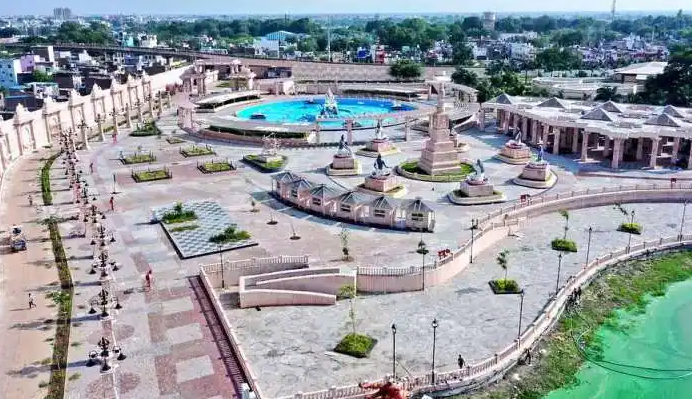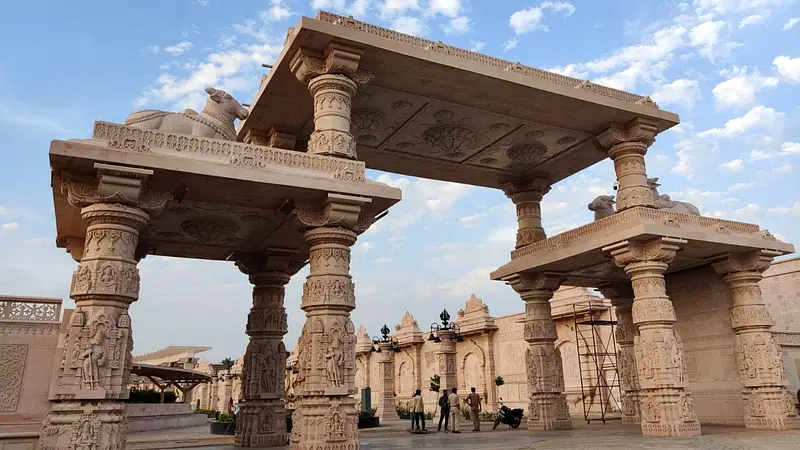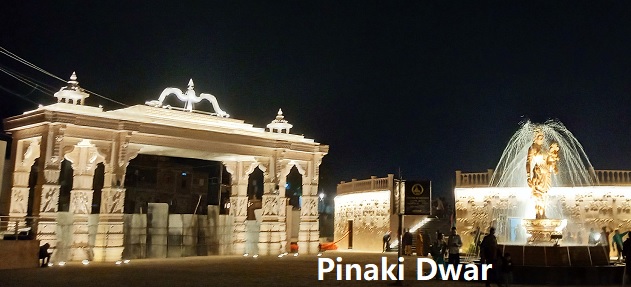
Shri Mahakaleshwar Mandir, Ujjain(Madhya Pradesh)
Situated amid the vibrant Ujjain city, the Mahakal Lok Corridor stands as a testament to divine craftsmanship and spiritual grandeur. Stretching more than 900 m, this sacred passage not only leads pilgrims to the renowned Mahakaleshwar Temple but also unfolds a captivating narrative through its ornate features and adjacent attractions.
Entry gates to the temple
Nandi Dwar

Shri Nandi Dwar, also known as the Nandi Gateway, is a grand entrance to the Mahakal Lok Corridor near the Ujjain Mahakal Temple. It is one of two majestic gateways, along with Pinaki Dwar, that mark the beginning of the journey into the corridor. The name “Nandi Dwar” pays homage to Lord Shiva’s sacred bull companion and symbolizes power and righteousness.
Pinaki Dwar

The Pinaki Dwar serves as one of the majestic entrances to the Mahakal Lok Corridor. Alongside the Nandi Dwar, it marks the beginning of the pathway leading to the Mahakaleshwar Temple. These gateways are strategically positioned near the starting point of the corridor, which winds its way to the entrance of the ancient temple, offering aesthetic views along the way.
The Temple
The temple is three-storeyed. In the lowest middle and uppermost parts are respectively installed the lingams of Mahakalesvara, Omkaresvara and Nagachandresvara. The pilgrims and the visitors can only have the glimse of Nagachandresvara on the festive of Naga Panchami. A very large-sized Kunda named Koti Tirtha also exists in the temple-complex. The Kunda is built in the sarvatobhadra style. The Kunda and its water both are treated as very celestial. On the path adjoining the stairs of the Kunda, may be seen many images representing the sculptural grandeur of the temple built during the Paramara period. In the east of the Kunda is a large-sized Veranda in which there is the entrance to the path leading to the garbhagrha. In the northern side of the verandah, in a cell, the images of Sri Rama and goddess Avantika are worshipped. In the southern side of the main shrine, there stand many small Saivite temples built during the shinde regime among these the temple of Vrddha Mahakalesvara, Anadi Kalpesvara and Saptarshi are prominent and are the remarkable pieces of architecture.
he lingam of Mahakalesvara is colossus. The silver plated Naga Jaladhari and the inscribed and esoteric silver-plate covering the roof of the garbhagrha add extra grandeur to the shrine. Besides Jyotirlinga, attractive and small-sized images of Ganesa, Kartikeya and Paravati can be seen in the garbhagrha. All around the walls classical eulogies in the praise of Lord Siva are exhibited. The Nanda Dipa always remains lit.
In the exit-path, there is a wide hall in which a most attractive metal quoted stone Nandi, in the sitting humble pose may be witnessed. The courtyard just opposite to the Omkaresvara temple add much to the magnanimity of the temple-complex. Just adjoining to this temple, there are two pillared projections facing the east and adding a lot to the architecture of the temple. The temple of Mahakalesvara is a planned admixture of the Bhumija, Chalukya and Maratha styles of architecture. The sikhara with the mini-srngas is very peculiar. In previous years its upper part has been covered with gold plate.
Aarti
Bhasm Aarti
Timings: 4:00 AM to 6:00 AM
The Bhasm Aarti is the most famous and significant ritual at the Mahakaleshwar Temple. During this ritual, the temple priests apply sacred ash (bhasm) to the Shiva Lingam while chanting Vedic mantras. Devotees from all over the world gather to witness this sacred ceremony, and it is an unforgettable spiritual experience. Arriving well in advance is advisable to secure a good view.
Rudrabhishek Puja
Timings:6:00 AM to 7:00 AM
The Rudrabhishek is a powerful and elaborate puja dedicated to Lord Shiva. It involves the ritualistic bathing of the Shiva Lingam with various sacred substances, including milk, yogurt, honey, ghee, and water, while chanting Vedic mantras. This puja is believed to invoke the blessings of Lord Shiva for health, prosperity, and spiritual growth.
Shrinagar Darshan
Timings:7:00 AM to 10:30 AM
The Shringar Darshan is a special puja that involves adorning the deity with various ornaments, flowers, and clothing. It usually takes place around noon and offers devotees a chance to see Lord Shiva in his decorated form.
Panchamrit Abhishek
Timings:10:30 AM to 12:00 PM
In the Panchamrit Abhishek, the Shiva Lingam is bathed with a mixture of five sacred liquids: milk, yogurt, honey, ghee, and sugar. This ritual is performed to seek purity and blessings from Lord Shiva.
Evening Aarti
Timings:6:00 PM to 7:00 PM (Varies with sunset time)
The evening Aarti is a significant ritual that takes place in the evening hours. Devotees gather to witness this ceremony, which involves the waving of large oil lamps and the singing of devotional songs in praise of Lord Shiva.
Night Puja
Timings:8:00 PM to 10:00 PM
This is a night puja that offers devotees an opportunity to seek Lord Shiva’s blessings in the peaceful ambiance of the temple at night. It includes the evening Aarti.
Bhagwan Bhasm Aarti
Timings: 6:00 AM (Varies slightly)
The Bhagwan Bhasm Aarti is a variant of the early morning Bhasm Aarti and is performed slightly later. It is a less crowded option for devotees who may not be able to attend the early morning ritual.
How To Reach
By Roadways
Ujjain is directly connected by road to Indore, Surat, Gwaliar, Pune, Mumbai, Ahmedabad, Jaipur, Udaypur, Nasik, Mathura.
By Railways
Ujjain is directly connected by railway line to Ahmedabad, Rajkot, Mumbai, Fouzabad, Lucknow,Dehradun, Delhi, Banaras, Kochin, Chennai, Bangalore, Hyderabad, Jaipur, Howrah and many more.
By Airways
Nearest airport is Indore (53 K.m.). Flights arriving from Mumbai, Delhi, Ahmedabad, Gwalior.
